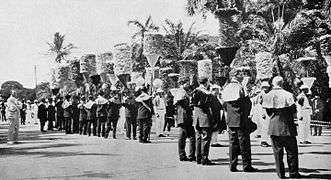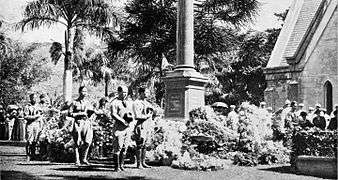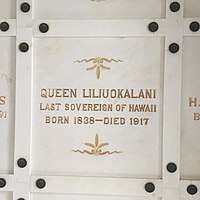Death and state funeral of Liliʻuokalani
Liliʻuokalani, the last monarch of Hawaii, died November 11, 1917. The royal standard (flag) was raised over her home at Washington Place to signal to the public that she was deceased. Under military guard, her body was moved at midnight for embalming. After the traditional Hawaiian mourning of chanting and wailing, the public was allowed to view her body covered only by a shroud. Her state funeral was held in the throne room of Iolani Palace, on November 18, 1917, followed by her funeral procession to the Royal Royal Mausoleum of Mauna ʻAla. An estimated 1,500 adults and children were in the funeral procession.
_(cropped).jpg)
Death
She died at her residence Washington Place, at 8:30 a.m. on November 11, 1917, at the age of seventy-nine.[1] According to her lady-in-waiting Lahilahi Webb, the Queen had been in rapidly failing health and diminished mental capacity during the weeks immediately preceding her death. Besides Webb, those who were with her at the end were her doctor William Cotton Hobdy, Prince Jonah Kūhiō Kalanianaʻole, and his wife Elizabeth Kahanu Kalanianaʻole. Her private secretary and trustee of her deed of trust, Curtis P. Iaukea, immediately raised her royal standard (flag) over Washington Place to signal her death. Iaukea's wife Charlotte Kahaloipua Hanks, and two elderly royal retainers Wakeke Ululani Heleluhe and Onaala, were also in attendance at the Queen's death.[2][3]
Immediately following a doctor's statement that life was gone, Rev. Leopold Kroll of the Hawaiian congregation of St. Andrew's Cathedral and Rev. Henry H. Parker, pastor of Kawaihao church were notified, and the bells began their sad tolling - 79 times they tolled, telling all Honolulu that Queen Lilliuolakani, 79 years old, was dead.
— Honolulu Star-Bulletin, [3]
State funeral
Iaukea was in charge of making the funeral arrangements, but territorial governor Lucius E. Pinkham accorded her the honor of a state funeral and took charge of it.[4] According to Hawaiian tradition, it was believed that the birth and death of an aliʻi would be heralded by a natural phenomena. Schools of the red āweoweo fish, traditionally associated with the death of a member of the Hawaiian royal family, were seen off the coast of Oahu months before Liliuokalani's death.[5]
Following the raising of the royal standard, Hawaiian royalty and non-royalty arrived to pay their respects. The Hawaiian National Guard under Brigadier General Samuel Johnson was stationed at the gates. In accordance with Native Hawaiian tradition that dictated the body of a deceased royal could only be moved after dark, Liliuokalani's body was transferred under military guard at midnight on Monday along torch-lit streets to Kawaiahaʻo Church for embalming. On Tuesday, her body lay in state for 12 hours without a casket, covered only by a silk shroud, for the traditional Hawaiian mourning of chanting and wailing. Afterwards, the body was placed inside the casket for viewing until 6 p.m. on Saturday.[3][4] She received a state funeral in the throne room of Iolani Palace, on November 18, 1917.[6][7]
As her catafalque was moved from the palace up Nuuanu Avenue with 1200-foot ropes pulled by 204 stevedores, for entombment with her family members in the Kalākaua Crypt of the Royal Mausoleum of Mauna ʻAla, composer Charles E. King led a youth choir in "Aloha ʻOe". The song was picked up by the procession participants and the crowds of people along the route.[8] Films were taken of the funeral procession and later stored at ʻĀinahau, the former residence of her sister and niece. A fire on August 1, 1921, destroyed the home and all its contents, including the footage of the Queen's funeral.[9]
For a week, the casket was placed on a bier in the underground Kalākaua Crypt where Webb, Wakeke and her daughter Myra Heleluhe stood vigil over the remains. On November 26, following a ceremony officiated by many of the participants of the earlier funeral, the casket was sealed in a niche adjoining the one containing her husband John Owen Dominis.[10]
W. F. Aldrich created a film of the state funeral.[11]
Since the state funeral took place during the recess of the territorial legislature, Kūhiō, Iaukea, William Owen Smith and five other businessmen and politicians borrowed money from the Bank of Hawaii to cover the expenditures. The state funeral cost the territorial government a total of $8,500.[11]
Procession order
Although exact counts vary in the news coverage, it was estimated that thousands adults and children marched in the funeral procession.[12][13] The order of procession also varied slightly in different sources.[14]
- Mounted and Foot Police
- Grand Marshal and Aides
- Capt. Henri Berger and the Royal Hawaiian Band
- Kamehameha School Cadets (120 cadets)
- 30 young boys and the school's officers
- Queen's Own Troop Boy Scouts
- St. Louis College Band
- Hawaiian Societies (more than 1500 people in this group) [12]
- Ahahui Kaahumanu – (30 members)[12] in black holoku and yellow feathered leis; included Lahihi Webb, Lydia Aholo
- Ahahui Poola
- Ancient Order of Foresters
- Court Lunalilo (200-plus)[13]
- Daughters of Warriors
- Hawaiian Chapter No. 1, Order of Kamehameha – (35 members) [12] – catafalque immediately followed this group
- Hui Kokua Hookuonoono o na Wahini Oiwi Hawaii [12] white and yellow leis (nearly 100 combined with men's)
- Hui Kokua Hookuonoono o na Kanaka Oiwi Hawaii[12] white uniforms and caps (about 50 men)
- Hui Kokua Ame (50 members) red shirts[12]
- Hui Mamona
- Kahale o na Alii "House of the Kings" (12 women)[12]
- Kalama Lodge (35 members)[12]
- Kamehameha Alumni Association (25 girls) [12]
- Koahelelani, 7 women, royal purple and yellow leis [12]
- Laie delegation L. D. S. Hui Manawela o na Wahini (about 100) [12]
- Children's branch of the L. D. S.[12]
- St. Andrew's Priory School Girls (78 young women)[12]
- St. Louis Alumni
- Second U. S. Infantry Band
- 1st Squadron of the Fourth U. S. Cavalry of Schofield Barracks (250 troopers)
- Battalion, First U. S. Field Artillery (90 men to each battery)
- Battery D did the 21-gun salute, each gun fired 1 minute apart
- Batteries E and F marched in the procession
- Second U. S. Infantry
- Detachment U. S. Marines
- Detachment U. S. Navy
- Coast Artillery Band
- Detachment H. I. J. M. Tokiwa's (138 sailors)
- Provisional Battalion National Guard (412 men)
- Companies A, B, C and D, 103 men in each company
- Physician of the late Queen, William Cotton Hobdy
- Retainers of the late Queen
- Choir boys of St. Andrews Cathedral
- Clergy
- Honorary Pallbearers[15]
- Governor Pinkham, US Senator Miles Poindexter of Washington, US Representative James C. McLaughlin of Michigan, Charles F. Chillingworth, president of the territorial senate, Henry Lincoln Holstein, speaker of the house. Chief Justice A. G. M. Robertson. William Owen Smith. Curtis P. Iaukea, E. Faxon Bishop, Brigadier General John P. Wisser, US Army, Captain George R. Clark, US Navy, Brigadier General Samuel I. Johnson, NGH.[15]
- Poolas drawing the Catafalque (204 stevedores)[16]
- Bearers of the Hawaiian Decorations
- Bearer of the Imperial Japanese Decorations
- Catafalque, Kāhili and Pallbearers
- Frederick William Beckley Jesse P. Makainai, David Hoapil, Albert K. Hoapili, David Maikai, William Simerson, G. K. Kealohapauole, Frederick Hank Iaukea, James Harbottle Boyd, Henry Franz Bertelmann, A. N. Alohikea, Thomas Pualiʻi Cummins, Edwin Kea, A. K. Nahaolelua, Henry Pitman Beckley[15]
- Prince Kalanianaʻole and Princess Kalanianaʻole
- Carriage of Princess Kawananakoa, representing Prince Kalakaua, Princess Kapiolani and Liliuokalani
- Governor and Aides
- Commanding Officer, Hawaiian Department and Aides
- Commandant Pearl Harbor Naval Station and Aides
- Adjutant General Territory of Hawaii and Aides
- The Congressional Party
- Secretary of the Territory of Hawaii
- Governor's Staff
- Staff of Department Commander
- Staff of Commandant Naval Station
- Chief Justice
- President of the Hawaiian Senate
- Speaker of the House of Representatives
- Justices of the Supreme Court
- Heads of Territorial Departments
- Officers U. S. Army and Navy
- Federal Officers
- Members of the Hawaiian Senate
- Members of the House of Representatives
- Members Consular Corps.
- Circuit Judges
- County Officials
- Board of Supervisors
- Various Societies, not Hawaiian
- Punahou Cadets
- Cadets Honolulu Military Academy
- Schools
Gallery
Citations
- Hodges 1918, pp. 35–37; Allen 1982, p. 396
- Iaukea 2012, p. 151
- "Death Comes to Hawaii's Queen in Calm of Sabbath Morning". Honolulu Star-Bulletin. Honolulu. November 12, 1917. p. 2. Retrieved February 4, 2017.
- Thrum 1918
- "The Return of the Weoweo". The Garden Island. Lihue. September 4, 1917. p. 1. Retrieved February 4, 2017.; "The Red Fish Invasion". The Maui News. Wailuku. November 16, 1917. p. 4. Retrieved February 4, 2017.; "Hawaiian Fears No Harm From Riding On Catafalque When Empty". Honolulu Star-Bulletin. Honolulu. November 19, 1917. p. 9. Retrieved February 4, 2017.; Bland, Oscar E. (1919). Ford, Alexander Hume (ed.). "Beautiful Hawaii". The Mid-Pacific Magazine. T. H., A. H. Ford; Pan-Pacific Union, Pan-Pacific Research Institution. XVIII (2): 149–152.CS1 maint: ref=harv (link)
- "Honors of Royalty Return to Liliuokalani after Death". The Hawaiian Gazette. X (93). Honolulu. November 20, 1917. p. 2. Retrieved February 4, 2017.
- "Funeral is Held in the Throne Room". The Hawaiian Gazette. X (93). Honolulu. November 20, 1917. p. 3. Retrieved February 4, 2017.
- Askman 2015, pp. 91–93; Allen 1982, pp. 396–400; Thrum 1918, pp. 102–109; Parker 2008, p. 36; ; "Funeral is Held in the Throne Room". The Hawaiian Gazette. X (93). Honolulu. November 20, 1917. p. 3. Retrieved February 4, 2017.; "Martial Pomp and Hawaiian Picturequeness in Funeral Cortege". Honolulu Star-Bulletin. Honolulu. November 19, 1917. p. 5. Retrieved February 4, 2017.; ""Aloha ʻOe" of Queen's Own Song Goes With Her Into Resting-Place". Honolulu Star-Bulletin. Honolulu. November 19, 1917. p. 9. Retrieved February 4, 2017.
- Allen 1982, p. 399; Gessler, Clifford F. (October 1921). "Honolulu Letter". The Step Ladder. III (5). Chicago. p. 76–77. Retrieved September 26, 2016.; "Ainahau Burns". The Maui News. 21 (1116). Wailuku. August 5, 1921. p. 8. Retrieved February 4, 2017.
- "Body of Queen Is Sealed Away In Royal Crypt". Honolulu Star-Bulletin. Honolulu. November 19, 1917. p. 9. Retrieved February 4, 2017.; "Body Of Queen Is Sealed In Niche". The Hawaiian Gazette. Honolulu. November 20, 1917. p. 7. Retrieved February 4, 2017.
- Kam 2017, pp. 165–166.
- "Hawaii's Societies Pay Last Meed of Homage to Hawaii's Last Queen". Honolulu Star-Bulletin. Honolulu. November 19, 1917. Retrieved February 4, 2017.
- "Silent Crowds With Bared Heads Mourn Passing of Queen Liliuokalani". Honolulu Star-Bulletin. Honolulu. November 19, 1917. p. 6. Retrieved February 4, 2017.
- "Martial Pomp and Hawaiian Picturequeness in Funeral Cortege". Honolulu Star-Bulletin. Honolulu. November 19, 1917. p. 5. Retrieved February 4, 2017.
- "Honorary And Active Pall-Bearers; Many Near Great Casket". Honolulu Star-Bulletin. Honolulu. November 19, 1917. p. 7. Retrieved February 4, 2017.
- "Names of the stevedores who participate in Queen Liliuokalani's funeral, 1917". nupepa. Retrieved February 4, 2017.
References
- Allen, Helena G. (1982). The Betrayal of Liliuokalani: Last Queen of Hawaii, 1838–1917. Glendale, CA: A. H. Clark Company. ISBN 978-0-87062-144-4. OCLC 9576325.CS1 maint: ref=harv (link)
- Askman, Douglas V. (2015). "Remembering Lili'uokalani: Coverage of the Death of the Last Queen of Hawai'i by Hawai'i's English-Language Establishment Press and American Newspapers". The Hawaiian Journal of History. Honolulu: Hawaiian Historical Society. 49: 91–118 – via Project MUSE.CS1 maint: ref=harv (link)
- Hodges, William C., Jr. (1918). The Passing of Liliuokalani. Honolulu: Honolulu Star Bulletin. OCLC 4564101.CS1 maint: ref=harv (link)
- Iaukea, Sydney L. (2012). The Queen and I: A Story of Dispossessions and Reconnections in Hawaiʻi. Berkeley: University of California Press. ISBN 978-0-520-95030-6. OCLC 763161035.CS1 maint: ref=harv (link)
- Parker, David "Kawika" (2008). "Crypts of the Ali`i The Last Refuge of the Hawaiian Royalty". Tales of Our Hawaiʻi (PDF). Honolulu: Alu Like, Inc. OCLC 309392477. Archived from the original (PDF) on November 11, 2013.CS1 maint: ref=harv (link)
- Thrum, Thomas G., ed. (1918). "Death, Lying-in-State and Obsequies of Queen Liliuokalani". Hawaiian Almanac and Annual for 1918. Honolulu: Honolulu Star-Bulletin. pp. 102–109.CS1 maint: ref=harv (link)
External links
| Wikimedia Commons has media related to Funeral of Liliuokalani. |
| Wikimedia Commons has media related to Funeral procession of Liliuokalani. |
.jpg)
.jpg)
.jpg)
.jpg)



